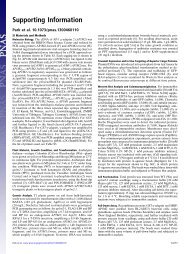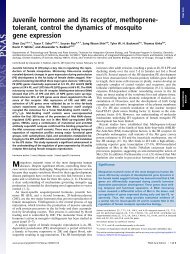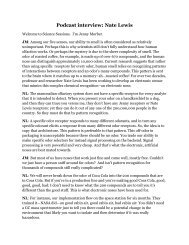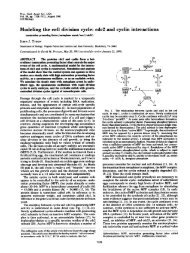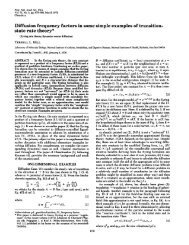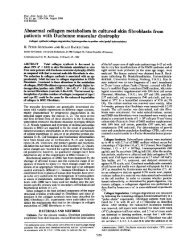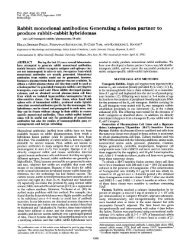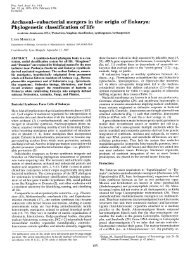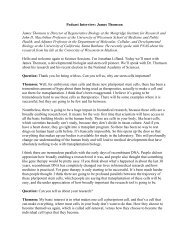Nonmuscle myosin II powered transport of newly formed collagen ...
Nonmuscle myosin II powered transport of newly formed collagen ...
Nonmuscle myosin II powered transport of newly formed collagen ...
Create successful ePaper yourself
Turn your PDF publications into a flip-book with our unique Google optimized e-Paper software.
<strong>Nonmuscle</strong> <strong>myosin</strong> <strong>II</strong> <strong>powered</strong> <strong>transport</strong> <strong>of</strong> <strong>newly</strong><br />
<strong>formed</strong> <strong>collagen</strong> fibrils at the plasma membrane<br />
Nicholas S. Kalson a,1 , Tobias Starborg a,1 , Yinhui Lu a , Aleksandr Mironov b , Sally M. Humphries a , David F. Holmes a ,<br />
and Karl E. Kadler a,2<br />
a Wellcome Trust Centre for Cell-Matrix Research and b Faculty <strong>of</strong> Life Sciences, University <strong>of</strong> Manchester, Manchester M13 9PT, United Kingdom<br />
Edited by Darwin J. Prockop, Texas A&M Health Science Center, Temple, TX, and approved October 15, 2013 (received for review July 30, 2013)<br />
Collagen fibrils can exceed thousands <strong>of</strong> microns in length and are<br />
therefore the longest, largest, and most size-pleomorphic protein<br />
polymers in vertebrates; thus, knowing how cells <strong>transport</strong> <strong>collagen</strong><br />
fibrils is essential for a more complete understanding <strong>of</strong><br />
protein <strong>transport</strong> and its role in tissue morphogenesis. Here, we<br />
identified <strong>newly</strong> <strong>formed</strong> <strong>collagen</strong> fibrils being <strong>transport</strong>ed at the<br />
surface <strong>of</strong> embryonic tendon cells in vivo by using serial block facescanning<br />
electron microscopy <strong>of</strong> the cell-matrix interface. Newly<br />
<strong>formed</strong> fibrils ranged in length from ∼1 to∼30 μm. The shortest<br />
(1–10 μm) occurred in intracellular fibricarriers; the longest (∼30<br />
μm) occurred in plasma membrane fibripositors. Fibrils and fibripositors<br />
were reduced in numbers when <strong>collagen</strong> secretion was<br />
blocked. ImmunoEM showed the absence <strong>of</strong> lysosomal-associated<br />
membrane protein 2 on fibricarriers and fibripositors and there<br />
was no effect <strong>of</strong> leupeptin on fibricarrier or fibripositor number<br />
and size, suggesting that fibricarriers and fibripositors are not part<br />
<strong>of</strong> a fibril degradation pathway. Blebbistatin decreased fibricarrier<br />
number and increased fibripositor length; thus, nonmuscle <strong>myosin</strong><br />
<strong>II</strong> (NM<strong>II</strong>) powers the <strong>transport</strong> <strong>of</strong> these compartments. Inhibition <strong>of</strong><br />
dynamin-dependent endocytosis with dynasore blocked fibricarrier<br />
formation and caused accumulation <strong>of</strong> fibrils in fibripositors.<br />
Data from fluid-phase HRP electron tomography showed that fibricarriers<br />
could originate at the plasma membrane. We propose that<br />
NM<strong>II</strong>-<strong>powered</strong> <strong>transport</strong> <strong>of</strong> <strong>newly</strong> <strong>formed</strong> <strong>collagen</strong> fibrils at the<br />
plasma membrane is fundamental to the development <strong>of</strong> <strong>collagen</strong><br />
fibril-rich tissues. A NM<strong>II</strong>-dependent cell-force model is presented as<br />
the basis for the creation and dynamics <strong>of</strong> fibripositor structures.<br />
3View | SBF-SEM | extracellular matrix | vesicle | actin<br />
Cells have sophisticated mechanisms for <strong>transport</strong>ing proteins<br />
from one location to another, <strong>of</strong>ten within membrane-bound<br />
vesicles that need to be <strong>of</strong> appropriate size and shape to accommodate<br />
the cargo. Collagen is a special case and is used as<br />
a model protein for studying protein <strong>transport</strong>; not only is <strong>collagen</strong><br />
the most abundant structural protein in vertebrates, but<br />
it is too large to be accommodated within conventional <strong>transport</strong><br />
vesicles. Moreover, <strong>collagen</strong> molecules self-assemble into<br />
structures <strong>of</strong> increasing size with each successive stage in the<br />
secretory pathway. The <strong>transport</strong>ed cargo increases from ∼0.5<br />
MDa in the endoplasmic reticulum (ER) to several teradaltons<br />
(TDa) at the plasma membrane where the molecules are organized<br />
into fibrils. The motivation for our study was to build<br />
a temporal, spatial, and directional road map <strong>of</strong> the movement<br />
<strong>of</strong> membrane-bound <strong>collagen</strong> fibrils at the plasma membrane as<br />
the basis for a complete understanding <strong>of</strong> how cells <strong>transport</strong><br />
<strong>collagen</strong> in the process <strong>of</strong> assembling a mechanically functional<br />
extracellular matrix (ECM).<br />
In brief, pro<strong>collagen</strong> (the biosynthetic precursor <strong>of</strong> <strong>collagen</strong>) is<br />
synthesized in the ER and is asymmetric and relatively large; triple<br />
helical pro<strong>collagen</strong> molecules are ∼1.5 nm diameter, ∼300 nm long,<br />
and have mass <strong>of</strong> ∼450 kDa. Tubular-saccular carriers containing<br />
pro<strong>collagen</strong> arise from specialized ER domains (1, 2). TANGO1<br />
recruits Sedlin and steers pro<strong>collagen</strong> into COP<strong>II</strong>-dependent ER<br />
exit sites (3, 4) before CUL3-KLHL12 ubiquitinates a pool <strong>of</strong><br />
sec31 molecules to drive pro<strong>collagen</strong> <strong>transport</strong> from the ER to<br />
the Golgi apparatus (reviewed by ref. 5). ER-to-Golgi carriers<br />
join the Golgi stacks by fusing with cis cisternae and induce the<br />
formation <strong>of</strong> intercisternal tubules. Pro<strong>collagen</strong> traverses the<br />
Golgi apparatus without leaving the cisternal lumen (6, 7).<br />
Once through the Golgi apparatus, pro<strong>collagen</strong> can travel in<br />
pleomorphic Golgi-to-plasma membrane carriers (GPCs) that<br />
can be 0.3–1.7 μm in length (8). Evidence from electron microscopy<br />
suggests that these carriers contain sheaves <strong>of</strong> pro<strong>collagen</strong><br />
molecules stacked in zero register (9). Conversion <strong>of</strong><br />
pro<strong>collagen</strong> to <strong>collagen</strong> culminates in the formation <strong>of</strong> elongated<br />
fibrils that can be millimeters in length and are the primary<br />
tensile element <strong>of</strong> diverse tissues (10–12). Different types <strong>of</strong><br />
<strong>collagen</strong> polymerize and form complexes with proteoglycans and<br />
other glycoproteins to form the largest assembles in vertebrate<br />
tissues (reviewed by ref. 13). The fibrils are deposited in embryonic<br />
tissues where they are ∼30 nm in diameter and contain<br />
∼350 <strong>collagen</strong> molecules in the cross-section (based on calculations<br />
by ref. 14); thus, the fibrils are ∼0.3 TDa/μm. Considering<br />
that the first-<strong>formed</strong> fibrils are a few microns in length and grow<br />
to several millimeters, the fibrils are the largest size range<br />
structures <strong>transport</strong>ed by cells.<br />
The fact that <strong>collagen</strong> fibrils in vivo are too narrow and too<br />
densely packed to be resolved by light microscopy precludes realtime<br />
studies <strong>of</strong> cell–fibril interactions in vivo. Thus, transmission<br />
electron microscopy (TEM) has emerged as the method <strong>of</strong> choice<br />
for in vivo fibril studies but is not without its challenges because<br />
<strong>of</strong> the tortuosity and extreme lengths <strong>of</strong> the fibrils. Trelstad and<br />
Hayashi, and later Birk and Trelstad, used serial section transmission<br />
electron microscopy (ssTEM) to image the cell-matrix<br />
Significance<br />
Collagen is the most abundant protein in vertebrates and is the<br />
building block <strong>of</strong> strong tissues such as tendons, skin, and<br />
bones. The fibrils can be millimeters long and occur in the extracellular<br />
matrix as a scaffold for tissue growth. Important<br />
questions remain unanswered about how cells assemble and<br />
<strong>transport</strong> the fibrils. We show here that <strong>collagen</strong> fibril assembly<br />
can occur at the plasma membrane in structures called<br />
fibripositors. We show that fibripositors are a nonmuscle <strong>myosin</strong><br />
<strong>II</strong> (NM<strong>II</strong>)-dependent mechanical interface between the<br />
actino<strong>myosin</strong> machinery and the extracellular matrix; thus, we<br />
propose a new function for NM<strong>II</strong>. A unique mechanism <strong>of</strong> fibril<br />
<strong>transport</strong> is presented as a basis for studies <strong>of</strong> tissue morphogenesis<br />
and conditions including wound healing and fibrosis.<br />
Author contributions: N.S.K., T.S., and K.E.K. designed research; N.S.K., T.S., Y.L., A.M.,<br />
and S.M.H. per<strong>formed</strong> research; N.S.K., T.S., D.F.H., and K.E.K. analyzed data; and N.S.K.,<br />
D.F.H., and K.E.K. wrote the paper.<br />
The authors declare no conflict <strong>of</strong> interest.<br />
This article is a PNAS Direct Submission.<br />
Freely available online through the PNAS open access option.<br />
1 N.S.K. and T.S. contributed equally to this work.<br />
2 To whom correspondence should be addressed. E-mail: karl.kadler@manchester.ac.uk.<br />
This article contains supporting information online at www.pnas.org/lookup/suppl/doi:10.<br />
1073/pnas.1314348110/-/DCSupplemental.<br />
CELL BIOLOGY PNAS PLUS<br />
www.pnas.org/cgi/doi/10.1073/pnas.1314348110 PNAS Early Edition | 1<strong>of</strong>10
interface in embryonic tendon and were among the first to identify<br />
<strong>collagen</strong> fibrils in plasma membrane recesses (15, 16). Using data<br />
from an image stack <strong>of</strong> ∼14 μm depth (which is approximately<br />
one-fourth the length <strong>of</strong> an embryonic tendon cell; ref. 15),<br />
Trelstad and Hayashi proposed that the fibrils are <strong>formed</strong> by the<br />
addition <strong>of</strong> subassemblies <strong>of</strong> <strong>collagen</strong> onto the ends <strong>of</strong> the fibrils<br />
in plasma membrane recesses (15). In later studies, using image<br />
stacks <strong>of</strong> depth ∼20 μm, Canty and coworkers described actindependent<br />
slender projections (called fibripositors) that contained<br />
deeper recesses in which <strong>collagen</strong> fibrils were located (17,<br />
18). The number <strong>of</strong> sections that can be cut for ssTEM limits the<br />
practicality <strong>of</strong> viewing entire cells and complete fibrils. However,<br />
serial block face-scanning electron microscopy (SBF-SEM; ref.<br />
19) has emerged as a practical alternative to ssTEM for studying<br />
<strong>collagen</strong> fibril assembly in vivo (20).<br />
The experiments described below used SBF-SEM to study how<br />
cells <strong>transport</strong> <strong>collagen</strong> fibrils in vivo. We identified an abundance<br />
<strong>of</strong> short <strong>newly</strong> <strong>formed</strong> fibrils associated with a variety <strong>of</strong><br />
plasma membrane morphologies and within intracellular fibricarriers;<br />
fibricarriers were identified that were larger than the<br />
GPCs and fibril vesicles that have been described previously. We<br />
show that <strong>collagen</strong> fibrils in fibricarriers and fibripositors decrease<br />
in abundance when pro<strong>collagen</strong> secretion from the ER is<br />
blocked by dimethyloxaloylglycine (DMOG), which is a potent<br />
inhibitor <strong>of</strong> prolyl 4-hydroxylase (21). We show that fibricarriers<br />
can originate at the plasma membrane and are <strong>transport</strong>ed into<br />
fibricarriers <strong>powered</strong> by nonmuscle <strong>myosin</strong> <strong>II</strong> (NM<strong>II</strong>) in a process<br />
that is blocked by dynasore inhibition <strong>of</strong> dynamin-dependent<br />
endocytosis (22). We propose a unique <strong>transport</strong> pathway in<br />
which new <strong>collagen</strong> fibrils assembling on the cell surface are<br />
moved through the cell in a process <strong>powered</strong> by NM<strong>II</strong>.<br />
Results<br />
Visualization <strong>of</strong> Entire Collagen Fibrils in Fibripositors and Fibricarriers.<br />
Fourteen-day-old chicken embryonic tendon was prepared for<br />
SBF-SEM by using 3View as described (20), and image analysis<br />
was per<strong>formed</strong> by using IMOD (23). Fig. 1A shows a 3D reconstruction<br />
<strong>of</strong> a typical cell that is elongated along the long axis <strong>of</strong><br />
the tendon and is surrounded by an ECM containing densely<br />
packed 30-nm-diameter <strong>collagen</strong> fibrils (Fig. 1B). The z range<br />
used in the experiment was sufficient to track complete <strong>collagen</strong><br />
fibrils at the cell-matrix interface in plasma membrane recesses<br />
(Fig. 1C).<br />
Fig. 2 A and B show data from two further cells. Examples <strong>of</strong><br />
fibrils with one tip in the ECM (the distal tip) and the other tip in<br />
fibripositors (the proximal tip) are highlighted blue and green.<br />
Approximately two-thirds <strong>of</strong> the number <strong>of</strong> fibripositors observed<br />
had a finger-like protrusion <strong>of</strong> the plasma membrane. We<br />
called these structures “protruding fibripositors.” The remainder<br />
<strong>of</strong> the fibripositors had the characteristic slender invagination <strong>of</strong><br />
the plasma membrane without the finger-like protrusion. We<br />
called these “recessed fibripositors.” The fibril highlighted in<br />
Fig. 1. Visualization <strong>of</strong> entire <strong>collagen</strong> fibrils at the cell-matrix interface by 3View SBF-SEM. SBF-SEM analysis <strong>of</strong> 14-d embryonic chick tendon with<br />
dimensions 30 μm × 30 μm × 100 μm (x, y, and z, respectively, with the z axis parallel to the long axis <strong>of</strong> the tendon) achieved by making 1,000 × 100 nm-thick<br />
cuts. The images were used for image analysis in IMOD. (A) Three-dimensional reconstruction <strong>of</strong> a single cell (outlined in orange) showing <strong>collagen</strong> fibrils<br />
(yellow) closely associated with the plasma membrane. An EM image is shown superimposed on the reconstruction. (B) Selected areas from cuts 413, 561, 663,<br />
816, and 977. Orange, the plasma membrane <strong>of</strong> the cell. (C) Higher magnification views <strong>of</strong> cuts 561 and 816. Orange, the plasma membrane <strong>of</strong> the cell; yellow<br />
circles, <strong>collagen</strong> fibrils in cytoplasmic compartments.<br />
2<strong>of</strong>10 | www.pnas.org/cgi/doi/10.1073/pnas.1314348110 Kalson et al.
Fig. 2. Quantitative length measurements <strong>of</strong> <strong>collagen</strong> fibrils in vivo. SBF-SEM<br />
volume <strong>of</strong> 14-d embryonic chick tendon with dimensions 30 μm × 30 μm ×<br />
100 μm (x, y, and z, respectively) achieved by making 1,000 × 100 nm-thick<br />
cuts. The images were used for image analysis in IMOD. (A) Part <strong>of</strong> a 3D<br />
reconstruction <strong>of</strong> a cell between cuts 739 and 953, equivalent to 21.4 μm<br />
along the long axis <strong>of</strong> the cell. EM images show selected areas <strong>of</strong> the cellmatrix<br />
interface. A <strong>collagen</strong> fibril (green) is shown with one tip at the base<br />
<strong>of</strong> the plasma membrane recess and the other extending through a protruding<br />
fibripositor with the other tip in the ECM (green line in the reconstruction<br />
and green circle in the 3View images). Also shown is a <strong>collagen</strong><br />
fibril with a tip within a plasma membrane recess and exiting the cell<br />
through a recessed fibripositor (blue). This dataset is shown in Movie S1. (B)<br />
Three-dimensional reconstruction <strong>of</strong> another cell showing a <strong>collagen</strong> fibril<br />
entirely contained within a membrane-bound cytoplasmic fibricarrier (purple).<br />
Selected cuts containing the fibricarrier are also shown with the fibricarrier<br />
circled in purple (520, 516, 460, and 450). This dataset in shown in<br />
Movie S2. (C) Schematic representation <strong>of</strong> the cell-matrix interface, illustrating<br />
the three membrane-fibril structures identified (FC, fibricarriers; PF,<br />
protruding fibripositors; RF, recessed fibripositors). Color scheme remains<br />
the same as in A and B. (D) Quantitation <strong>of</strong> the lengths <strong>of</strong> fibrils in fibricarriers,<br />
recessed fibripositors, protruding fibripositors, and in the ECM. *,<br />
significant difference in fibril length (P ≤ 0.05).<br />
green (Fig. 2A) is representative <strong>of</strong> a fibril with its proximal tip<br />
within a protruding fibripositor and its distal tip in the ECM. The<br />
fibril highlighted in blue has its distal tip in the ECM and its<br />
proximal tip within a recessed fibripositor (shown schematically<br />
in Fig. 2C). Movie S1 is a movie showing a recessed fibripositor<br />
and a protruding fibripositor. Fig. 2B shows a <strong>collagen</strong> fibril<br />
enclosed within a fibricarrier. Fibricarriers accounted for ∼5% <strong>of</strong><br />
fibril-containing compartments (i.e., fibricarriers + recessed<br />
fibripositors + protruding fibripositors). The fibril in the fibricarrier<br />
is highlighted purple in the 3D reconstruction and 3View<br />
images. The 3View images <strong>of</strong> a fibricarrier are shown in Movie<br />
S2. The lengths <strong>of</strong> fibrils in the different compartments were as<br />
follows: fibricarriers (5.7 ± 1.4 μm), recessed fibripositors (14.9 ±<br />
1.7 μm), and protruding fibripositors (31.2 ± 2.9 μm; Fig. 2D).<br />
Fibrils leaving the cell through recessed fibripositors were commonly<br />
seen to run along the external surface <strong>of</strong> the cell before<br />
either terminating in a fibril tip or tracking away from the cell<br />
surface and entering a bundle <strong>of</strong> fibrils. Conversely, fibrils leaving<br />
the cell in protruding fibripositors were positioned with the end<br />
<strong>of</strong> the membrane protrusion within a fibril bundle. This difference<br />
in fibril positioning is demonstrated in Fig. 2A in which the<br />
recessed fibripositor fibril runs along the surface <strong>of</strong> the cell (blue<br />
fibril), whereas the protruding fibripositor projects directly into<br />
the matrix (green fibril). The length <strong>of</strong> the finger-like component<br />
<strong>of</strong> protruding fibripositors ranged from
Fibricarriers Can Be Formed at the Plasma Membrane. We used solution-phase<br />
horseradish peroxidase (HRP) according to the<br />
schematic shown in Fig. 5A to investigate if fibricarriers can be<br />
<strong>formed</strong> at the plasma membrane in a process analogous to endocytosis.<br />
We subsequently stained with diaminobenzidine (DAB)<br />
and osmium, embedded the samples for TEM, per<strong>formed</strong> electron<br />
tomography on 63 300-nm–thick serial sections, and stacked the<br />
tomograms (Fig. 5 B–D) to generate a combined 3D volume <strong>of</strong> z<br />
depth 18.9 μm. Examination <strong>of</strong> the stacked tomogram showed the<br />
presence <strong>of</strong> both electron dense (HRP containing) and electron<br />
lucent (not containing HRP) fibricarriers: 15 <strong>of</strong> 25 fibricarriers<br />
were electron dense, whereas 10 were electron lucent.<br />
Fig. 3. Cytoplasmic fibrils are not degraded by lysosomal proteases. (A)<br />
ImmunoEM on cryosections <strong>of</strong> embryonic mouse tail by using an anti-LAMP2<br />
antibody localized LAMP2 to endosome structures in the cytoplasm but not<br />
to <strong>collagen</strong> fibril-containing compartments (arrow). (B) Endocytic uptake <strong>of</strong><br />
fluorescent-labeled EGFR after 30-min incubation revealed loss <strong>of</strong> fluorescence<br />
in the presence, but not the absence, <strong>of</strong> leupeptin. (C) Quantitation <strong>of</strong><br />
fibril-containing compartments after treatment with leupeptin. Treatment<br />
with leupeptin (48 h) did not affect the proportion <strong>of</strong> fibrils in recessed or<br />
protruding fibripositors or the total number <strong>of</strong> intracellular fibrils. † P > 0.05.<br />
(Scale bars: A, 1μm; B, 5μm.)<br />
ECM. These data suggested that fibripositors might be a site <strong>of</strong><br />
fibril assembly. Therefore, in the next experiment, we incubated<br />
tendons with the prolyl 4-hydroxylase inhibitor DMOG (21) for<br />
48 h to block <strong>collagen</strong> export from the ER (Fig. 4A) and examined<br />
the cells in situ by SBF-SEM (Fig. 4B). The results<br />
showed that DMOG reduced the number <strong>of</strong> short fibrils and<br />
fibril-containing compartments (fibricarriers and fibripositors).<br />
In particular, the number <strong>of</strong> protruding fibripositors was reduced<br />
from ∼6 per cell in DMSO control samples to ∼1 per cell in<br />
DMOG-treated samples (Fig. 4 B and C). Thus, blocking <strong>collagen</strong><br />
secretion reduced the number <strong>of</strong> fibripositors.<br />
Next, we incubated tendons with GM6001 (a broad-spectrum<br />
inhibitor <strong>of</strong> matrix metalloproteinases; MMPs) and used SBF-<br />
SEM to identify short fibrils. In contrast to results with DMOG,<br />
GM6001 did not prevent the occurrence <strong>of</strong> short fibrils at the cell<br />
surface in fibripositors (representative cell reconstruction in Fig.<br />
S2A). Zymography showed that GM6001 was active under the<br />
conditions used (Fig. S2B).<br />
NM<strong>II</strong> Powers the Transport <strong>of</strong> Newly Formed Fibrils at Fibripositors.<br />
Meshel et al. showed that cultured fibroblasts use NM<strong>II</strong> to power<br />
the contraction <strong>of</strong> lamellipodia attached to <strong>collagen</strong> fibrils,<br />
thereby causing the cell to move (32). To test the hypothesis that<br />
NM<strong>II</strong> might power the pulling on fibrils at fibripositors, we used<br />
blebbistatin in a 3D tendon-like cell-culture system that successfully<br />
recapitulates key aspects <strong>of</strong> embryonic tendon development<br />
(33, 34). We show here that when tension is released<br />
in the tendon-like constructs by removal <strong>of</strong> an anchor post, the<br />
constructs contract to approximately one-fifth <strong>of</strong> their original<br />
length (compare Fig. 6A, Left and Center). However, when the<br />
constructs are incubated with blebbistatin no contraction occurred<br />
(compare Fig. 6A, Left and Right). Experiments with<br />
embryonic tendon cells in 2D demonstrated that inhibition <strong>of</strong><br />
NM<strong>II</strong> resulted in disruption <strong>of</strong> normal membrane dynamics, with<br />
more protrusive activity resulting in longer filopodia, as reported<br />
(35) (Fig. 6B). SBF-SEM analysis <strong>of</strong> tendon-like constructs<br />
treated with blebbistatin more than doubled the length <strong>of</strong> the<br />
protrusive part <strong>of</strong> the fibripositor (Fig. 6C) and reduced numbers<br />
<strong>of</strong> protruding fibripositors and fibricarriers (Fig. 6 D and E).<br />
Three-dimensional reconstructions are shown in Fig. 6E. Aschematic<br />
representation <strong>of</strong> the effect <strong>of</strong> NM<strong>II</strong> inhibition—fewer,<br />
longer protrusive fibripositors, and fewer fibricarriers—is shown<br />
in Fig. 6F.<br />
In further experiments, we showed that inhibiting dynamin<br />
with dynasore resulted in marked disorganization <strong>of</strong> fibricarriers<br />
and fibripositors (Fig. 7). In control samples, single fibrils are<br />
seen within the internal part <strong>of</strong> protrusive fibripositors and in<br />
recessed fibripositors (Fig. 7A, Upper), whereas in dynasoretreated<br />
tendon, multiple fibrils are seen in these compartments<br />
(Fig. 7A, Lower). Three-dimensional reconstruction revealed<br />
that these compartments were morphologically abnormal and<br />
disorganized, some looping inside the cell (Fig. 7B and Movie S4).<br />
Quantification revealed that the length <strong>of</strong> the protrusive part <strong>of</strong><br />
fibripositors was not affected by treatment with dynasore (Fig. 7C).<br />
However, the length <strong>of</strong> the internal part <strong>of</strong> protrusive fibripositors<br />
and <strong>of</strong> recessed fibripositors was significantly increased (Fig.<br />
7D). Furthermore, similar to the finding in blebbistatin-treated<br />
tendon, dynasore reduced the number <strong>of</strong> fibricarriers (Fig. 7E).<br />
The finding <strong>of</strong> long, looped plasma membrane recesses and the<br />
absence <strong>of</strong> fibricarriers (shown schematically in Fig. 7F) suggested<br />
that internalization <strong>of</strong> <strong>collagen</strong> fibrils within fibricarriers<br />
(<strong>powered</strong> by NM<strong>II</strong>) is an endocytic-like process.<br />
Actin Clustering at Collagen Fibril Interaction Sites in Fibripositors.<br />
Previous observations that fibripositors are disassembled after<br />
treatment with cytochalasin B (18) prompted analysis <strong>of</strong> our new<br />
datasets for evidence <strong>of</strong> fibrils being grasped within fibripositors.<br />
Longitudinal sections <strong>of</strong> fibripositors showed the presence <strong>of</strong> corrugations<br />
<strong>of</strong> the lumen in which the fibril is pinched at ∼10 locations<br />
along the length <strong>of</strong> the fibripositor (Fig. 8A). TEM analysis<br />
identified increased abundance <strong>of</strong> intracellular fine filaments, consistent<br />
with F-actin, at pinch points (Fig. 8C). Three-dimensional<br />
reconstructions showed that the pinch points occurred at regular<br />
intervals along recessed and protruding fibripositors (Fig. 8D and<br />
Movie S5).<br />
4<strong>of</strong>10 | www.pnas.org/cgi/doi/10.1073/pnas.1314348110 Kalson et al.
CELL BIOLOGY PNAS PLUS<br />
Fig. 4. Protruding and recessed fibripositors contain <strong>newly</strong> synthesized <strong>collagen</strong> fibrils. Pulse–chase analysis <strong>of</strong> embryonic tendon demonstrated that pro<strong>collagen</strong><br />
processing and secretion was prevented by DMOG and reduced the numbers <strong>of</strong> fibripositors and fibricarriers. (A) Proteins were sequentially<br />
extracted in neutral salt buffer (S1) and buffer containing Nonidet P-40 (N), and the 14 C-labeled proteins were analyzed by SDS/PAGE and autoradiography.<br />
The identity <strong>of</strong> polypeptide chains <strong>of</strong> pro<strong>collagen</strong>, pC-<strong>collagen</strong>, and <strong>collagen</strong> are indicated. (B) Visualization <strong>of</strong> the cell-matrix interface by SBF-SEM before<br />
and after treatment with DMOG for 48 h. Fewer fibrils occurred in fibricarriers (purple), protruding (green), and recessed (blue) fibripositors. (Scale bar: 2 μm.)<br />
(C) Quantitation <strong>of</strong> the frequency <strong>of</strong> fibril-containing compartments before and after inhibition <strong>of</strong> pro<strong>collagen</strong> secretion by DMOG. *P ≤ 0.05.<br />
Discussion<br />
We have determined the shape, size, and 3D organization <strong>of</strong><br />
fibripositors and fibricarriers, which contain new <strong>collagen</strong> fibrils,<br />
at the plasma membrane and in the cytoplasm in vivo. It is<br />
possible to obtain a spatial map <strong>of</strong> the origin, location, and size<br />
<strong>of</strong> these compartments that contain fibrils <strong>of</strong> particular length<br />
ranges: Fibrils increased in length in the order <strong>of</strong> fibricarriers<br />
(1–10 μm), recessed fibripositors (5–30 μm), and protruding fibripositors<br />
(5–40 μm), with the longest occurring in the ECM (100–<br />
600 μm). The steady increase in fibril length suggested that these<br />
compartments are part <strong>of</strong> a common fibril-<strong>transport</strong> pathway. The<br />
inhibition <strong>of</strong> pro<strong>collagen</strong> synthesis, NM<strong>II</strong>, and dynamin in conjunction<br />
with SBF-SEM 3D reconstruction (20) has indicated the<br />
direction <strong>of</strong> fibril <strong>transport</strong>.<br />
At first sight, the range <strong>of</strong> fibril lengths in the different compartments<br />
could be interpreted to fit either a degradation or<br />
assembly pathway. If degradation is occurring, it could be reasoned<br />
that ECM fibrils are progressively reduced in length until<br />
the shortest fibrils are contained within fibricarriers. Conversely,<br />
fibrils in fibricarriers could grow to become fibrils in recessed<br />
fibripositors, then protruding fibripositors, and then released to<br />
the ECM. To distinguish between these two possibilities, we used<br />
leupeptin to inhibit lysosomal degradation, immunoEM to locate<br />
the endosomal marker LAMP2, and DMOG to inhibit pro<strong>collagen</strong><br />
secretion. Studies <strong>of</strong> periodontal ligament in postnatal<br />
mice showed that inhibiting lysosomal function using leupeptin<br />
resulted in an increase in vacuolar fibrils (29). Further studies<br />
showed that blocking <strong>collagen</strong> synthesis or disrupting microtubule<br />
polymerization (which inhibits <strong>collagen</strong> secretion; ref. 18)<br />
had no effect on the numbers <strong>of</strong> fibril-containing vacuoles (28).<br />
The conclusion from these studies was that <strong>collagen</strong> fibrils could<br />
be segregated from the matrix and degraded within lysosomal<br />
compartments. The results here showed that fibricarriers and<br />
fibripositors lack LAMP2 staining and are unaffected by leupeptin.<br />
Furthermore, their numbers decrease and there is an absence <strong>of</strong><br />
short fibrils at the plasma membrane in the presence <strong>of</strong> DMOG.<br />
Thus, in the absence <strong>of</strong> pro<strong>collagen</strong> molecules passing through the<br />
secretory pathway, no new fibrils assembled at the cell surface and<br />
the number <strong>of</strong> fibripositors was reduced. We also considered the<br />
possibility that short fibrils at the cell surface could be <strong>formed</strong> by<br />
cleavage <strong>of</strong> preexisting fibrils. Experiments with an MMP inhibitor<br />
suggested that active MMPs capable <strong>of</strong> cleaving <strong>collagen</strong> molecules<br />
are not required for the formation <strong>of</strong> short fibrils. These<br />
experiments showed that fibricarriers and fibripositors contain<br />
new <strong>collagen</strong> fibrils and that the fibrils are not being degraded.<br />
To test if fibricarriers could be <strong>formed</strong> by internalization <strong>of</strong><br />
<strong>collagen</strong> fibrils, we incubated tendon tissue with solution phase<br />
HRP. After incubation, a significant proportion <strong>of</strong> fibricarriers<br />
contained a dark precipitate, suggesting that they <strong>formed</strong> through<br />
an endocytic process. It is possible that HRP could be delivered<br />
to fibricarriers by pinocytosis <strong>of</strong> HRP-containing fluid from the<br />
ECM and subsequent fusion <strong>of</strong> the vesicle with fibricarriers.<br />
However, the surfaces <strong>of</strong> fibricarriers were smooth and lacked evidence<br />
<strong>of</strong> overt fusion with other compartments. Non-HRP–stained<br />
Kalson et al. PNAS Early Edition | 5<strong>of</strong>10
Fig. 5. Fibricarriers can be generated by out-to-in fibril <strong>transport</strong>. (A)<br />
Schematic representation <strong>of</strong> the HRP experiment. Orange dots represent<br />
HRP molecules. Brown-colored compartments represent compartments that<br />
are positive for electron-dense stain. (B) A virtual slice through a 3D EM<br />
tomogram <strong>of</strong> 13-d chicken embryonic metatarsal tendon that had been incubated<br />
with HRP solution for 4 h before fixation. Internal fibrils containing<br />
an electron-dense precipitate are seen (open arrowhead) together with internal<br />
fibrils with no precipitate (closed arrowhead). (C) Three-dimensional<br />
reconstruction from 65 serial section tomograms. Fibricarriers containing<br />
electron dense precipitate are shown in red, fibricarriers with no stain are<br />
purple. HRP-stained fibrils found within protruding and recessed fibripositors<br />
are shown in yellow, and unstained fibrils in recessed and protruding<br />
fibripositors are green. (D) Three-dimensional reconstruction <strong>of</strong> the stacked<br />
serial section tomogram dataset showing a cell membrane (light blue),<br />
nucleus (purple), and fibripositor-associated fibrils (yellow) and fibrils in<br />
fibricarriers (red). Note: Protruding and recessed fibripositors are not differentiated<br />
in the serial tomogram reconstruction because the relatively<br />
shallow sample volume (20 μm) precluded their characterization. (Scale bars:<br />
B, 500 nm; C, 2μm; D, 5μm.)<br />
fibricarriers could occur because they had <strong>formed</strong> before the 4-h<br />
incubation period and remained internal to the cell during the<br />
time course <strong>of</strong> the experiment. Nevertheless, the presence <strong>of</strong><br />
osmophilic stained fibricarriers is good evidence that they <strong>formed</strong><br />
at the plasma membrane and pinched <strong>of</strong>f from the membrane<br />
during the HRP-incubation period.<br />
Transport <strong>of</strong> fibricarriers and fibripositors is expected to require<br />
a cytoskeletal scaffold and a source <strong>of</strong> energy. Plasma<br />
membrane protrusive structures such as lamellipodia, microspikes,<br />
and pseudopodia possess an actin cytoskeleton for scaffolding<br />
support. Similarly, fibripositors are actin-dependent<br />
protrusions as shown by their disappearance in the presence<br />
<strong>of</strong> cytochalasin B (18). Notably, nocodozole had no affect on<br />
fibripositor or fibricarrier structure (18). We showed here using<br />
TEM that clouds <strong>of</strong> fine filaments are present at focal points <strong>of</strong><br />
contact between the internal membrane <strong>of</strong> the fibripositor and<br />
the luminal <strong>collagen</strong> fibril. The location <strong>of</strong> actin filaments in<br />
pinch points would explain why cytochalasin B is effective in<br />
releasing <strong>collagen</strong> fibrils from the surface <strong>of</strong> cells, resulting in the<br />
collapse <strong>of</strong> fibripositors (18).<br />
The formation <strong>of</strong> fibricarriers at the plasma membrane implies<br />
that a pulling force is exerted on the fibril tip. Also, the fact<br />
that fibrils in fibripositors are straight is indirect evidence that<br />
fibril tips are pulled. In subsequent experiments, we investigated<br />
if NM<strong>II</strong> was responsible for <strong>transport</strong>ing fibricarriers and fibripositors.<br />
Blebbistatin was highly effective in inhibiting the contraction<br />
<strong>of</strong> a 3D tendon-like construct. The range in length <strong>of</strong> the<br />
membrane projection <strong>of</strong> protruding fibripositors (from 1 to<br />
25 μm) suggests a growth process in which membrane is pushed<br />
(or pulled) out and retracted. SBF-SEM analyses showed that<br />
blebbistatin led to the significant increase in fibripositor mean<br />
length (from ∼6 μm to∼17 μm). Presumably the mean length <strong>of</strong><br />
the fibripositor is a consequence <strong>of</strong> NM<strong>II</strong>-<strong>powered</strong> inward<br />
pulling on the fibripositor and an opposing tissue tension that<br />
acts to pull the fibril <strong>of</strong>f the plasma membrane; the pinch points<br />
increase stress transfer from the fibril to the plasma membrane<br />
and vice versa. The data indicate that NM<strong>II</strong> is critically involved<br />
in the creation and dynamics <strong>of</strong> fibripositor structures; the exertion<br />
<strong>of</strong> force on fibripositors indicates that these structures are<br />
a mechanical interface between the cell and the ECM. Differences<br />
were also found in the position <strong>of</strong> fibrils in protruding<br />
and recessed fibripositors: Protruding fibripositor fibrils <strong>of</strong>ten<br />
project into the matrix, whereas recessed fibripositor fibrils<br />
<strong>of</strong>ten sit on the plasma membrane. This difference might indicate<br />
differences in forces exerted on fibrils in recessed and<br />
protruding fibripositors.<br />
Fig. 9 shows a model <strong>of</strong> a regulatory system that is consistent<br />
with data from our laboratory and others. The model shows<br />
the following: Initial <strong>collagen</strong> fibril nucleation can occur at the<br />
plasma membrane, fibril formation occurs by accretion <strong>of</strong> <strong>collagen</strong><br />
molecules (10, 36) or <strong>collagen</strong> aggregates (9), subsequent<br />
fibripositor formation around individual fibrils is then driven by<br />
cellular forces acting on the fibril and depends on the degree <strong>of</strong><br />
attachment <strong>of</strong> these fibrils to the cell (via pinch points) and the<br />
ECM, and the length <strong>of</strong> the finger-like portion <strong>of</strong> the protruding<br />
fibripositor is the result <strong>of</strong> opposing forces <strong>of</strong> NM<strong>II</strong> and tissue<br />
tension. The finding that fibricarriers can contain fluid-phase<br />
HRP and are removed by blebbistatin, dynasore, and DMOG<br />
suggests that these fibril-containing compartments can originate<br />
at the plasma membrane. Work by others has identified pro<strong>collagen</strong>-containing<br />
GPCs en route from the Golgi apparatus to<br />
the plasma membrane (8). Therefore, as indicated in Fig. 9, it is<br />
possible that fibricarriers could be a type <strong>of</strong> GPC and might cycle<br />
between the plasma membrane and the cytoplasm. Alternatively,<br />
fibricarriers might be <strong>formed</strong> by the inclusion <strong>of</strong> short early fibrils<br />
that are not anchored in the ECM. Consequently, NM<strong>II</strong>-<strong>powered</strong><br />
pulling on the fibril would not be counteracted by tissue tension.<br />
Importantly, these two schemes are not mutually exclusive, in<br />
either case, the short fibril would be encapsulated in a fibricarrier.<br />
Internalization <strong>of</strong> short, nonanchored fibrils to generate<br />
fibricarriers may thus be an incidental process in the formation <strong>of</strong><br />
6<strong>of</strong>10 | www.pnas.org/cgi/doi/10.1073/pnas.1314348110 Kalson et al.
CELL BIOLOGY PNAS PLUS<br />
Fig. 6. NM<strong>II</strong> is required for fibricarrier formation and normal fibripositor membrane dynamics. (A) Addition <strong>of</strong> blebbistatin to tendon-like constructs prevented<br />
cell-induced shortening when the constructs were unpinned. Arrow (black) shows the tendon-like construct. (B) Protrusive membrane dynamics (such<br />
as filopodia formation) are disrupted by blebbistatin. (Upper Right) Nonblebbistatin DMSO control. (Lower Right) Cell in the presence <strong>of</strong> blebbistatin. Arrowhead<br />
shows filopodia. *P ≤ 0.05. (C) Analysis <strong>of</strong> 3D EM data showed that the membrane protrusion <strong>of</strong> protrusive fibripositors is longer when NM<strong>II</strong> is<br />
inhibited in embryonic tendon. Bars show the length <strong>of</strong> the membrane protrusion (*P ≤ 0.05). (D) The proportion <strong>of</strong> intracellular fibrils in protrusive fibripositors<br />
is decreased when NM<strong>II</strong> is inhibited with blebbistatin for 4 h. Blebbistatin also reduced the proportion <strong>of</strong> internal fibrils found in fibricarriers. (E)<br />
Three-dimensional reconstructions <strong>of</strong> tendon treated with blebbistatin demonstrate increased numbers <strong>of</strong> recessed fibripositors (blue) and reduced the<br />
numbers <strong>of</strong> protruding fibripositors (green) with fewer fibricarriers (purple). (F) Schematic representation <strong>of</strong> the effect <strong>of</strong> NM<strong>II</strong> inhibition, showing longer<br />
fibripositors and fewer fibricarriers. *P ≤ 0.05. (Scale bars: 5 μm.)<br />
tensioned <strong>collagen</strong> fibrils. The <strong>transport</strong> <strong>of</strong> fibrils from the cell<br />
surface into fibricarriers requires membrane scission, as shown<br />
when dynasore resulted in the absence <strong>of</strong> fibricarriers, the deepening<br />
<strong>of</strong> recessed fibripositors, and the concomitant appearance <strong>of</strong><br />
looped fibrils in deep recesses.<br />
In conclusion, we propose that dynamic <strong>transport</strong> <strong>of</strong> new<br />
<strong>collagen</strong> fibrils occurs at the plasma membrane and that this<br />
process is driven by NM<strong>II</strong>. In this scheme, fibripositors are specialized<br />
sites <strong>of</strong> fibril assembly and fibril <strong>transport</strong>. The fibripositors<br />
form an extended mechanical interface between the cytoskeleton<br />
and extracellular <strong>collagen</strong> fibrils. This interface serves to transmit<br />
cell-derived tensioning force to the tissue, which is critical in<br />
maintaining fibril alignment. In addition, external loads are<br />
transmitted back to the cell via fibripositors to provide mechanical<br />
feedback during the development <strong>of</strong> the tissue.<br />
Materials and Methods<br />
Chicken Embryonic Tendon Experiments. Whole chick legs were dissected to<br />
expose metatarsal tendons and incubated in DMEM/nutrient mixture F-12<br />
containing 100 units/mL penicillin, 100 μg/mL streptomycin, 2 mM L-glutamine,<br />
200 mM L-ascorbic acid 2-phosphate, supplemented with 25 μM blebbistatin<br />
(48 h), 10 μM dynasore (48 h), 1 mM DMOG (48 h), 300 μM leupeptin (48 h),<br />
or 0.1% (vol/vol) DMSO. Reagents were purchased from Sigma. Samples<br />
were then fixed and processed for EM. The activity <strong>of</strong> leupeptin to prevent<br />
lysosome catheptic enzyme activity was investigated by incubating embryonic<br />
chick tendon cells with leupeptin for 2 h, then adding normal media<br />
supplemented with leupeptin and fluorescent EGFR (Invitrogen) for 15 min<br />
Kalson et al. PNAS Early Edition | 7<strong>of</strong>10
fixed in situ by using 2% (wt/vol) glutaraldehyde (Agar Scientific) in 0.1 M<br />
cacodylate buffer (pH 7.2), en-bloc stained in 1% (wt/vol) osmium tetroxide,<br />
1.5% (wt/vol) potassium ferrocyanide in 0.1 M cacodylate buffer, followed<br />
by 1% (wt/vol) tannic acid in 0.1 M cacodylate buffer (pH 7.2). After washing,<br />
more osmium was added by staining in 1% (wt/vol) osmium tetroxide in<br />
0.1 M cacodylate buffer (pH 7.2). The final staining step involved soaking in<br />
1% (wt/vol) uranyl acetate. Samples were dehydrated in ethanol and infiltrated<br />
in Araldite resin (CY212; Agar Scientific).<br />
SBF-SEM. Resin-embedded samples (150 in total during the study) were sectioned<br />
by using a Gatan 3View microtome within an FEI Quanta 250 scanning microscope<br />
as described (20). For these experiments, a 41 μm × 41 μm field <strong>of</strong> view was<br />
chosen and imaged by using a 4096 × 4096 scan, which gave an approximate<br />
pixel size <strong>of</strong> 10 nm. The section thickness was set to 100 nm in the Z (cutting)<br />
direction. Typically, Z volumes datasets comprised 1,000 images (100 μm z depth).<br />
Image analysis. The IMOD suite <strong>of</strong> image analysis s<strong>of</strong>tware was used to build<br />
image stacks, reduce imaging noise, and build 3D reconstructions (23). Fibrils<br />
were tracked from their cell-associated tip along the length <strong>of</strong> the fibril to<br />
determine their subcellular localization. Estimates <strong>of</strong> the length <strong>of</strong> ECM<br />
fibrils were made by tracing individual <strong>collagen</strong> fibrils (n = 500) over 100<br />
serial images, as described (20). The lengths <strong>of</strong> fibripositors and fibricarriers<br />
were calculated by tracing the complete fibril from its tip in the intracellular<br />
recess to its tip in the ECM (n = 50 protruding fibripositors, 50 recessed<br />
fibripositors, and 50 fibricarriers from two independent samples). The<br />
number <strong>of</strong> fibripositors (recessed, protruding) and fibricarriers per cell was<br />
calculated from IMOD reconstructions <strong>of</strong> a minimum <strong>of</strong> four cells for each<br />
experimental condition from two independent tendon samples (eight cells<br />
in total for DMOG, leupeptin, and DMSO). Each cell was entirely contained<br />
within the reconstructed volume. The effect <strong>of</strong> blebbistatin and dynasore<br />
on the length <strong>of</strong> the membrane protrusion part <strong>of</strong> protrusive fibripositors was<br />
Fig. 7. Inhibition <strong>of</strong> dynamin reduces the number <strong>of</strong> fibricarriers. (A) SBF-<br />
SEM images <strong>of</strong> embryonic chick tendon treated with dynasore demonstrated<br />
the appearance <strong>of</strong> intracellular fibril compartments containing increased<br />
numbers <strong>of</strong> fibrils (marked with a closed arrowhead). Open arrowheads<br />
mark recesses containing single fibrils seen in tendon not treated with<br />
dynasore. (B) Investigation <strong>of</strong> this finding in 3D demonstrated that the increased<br />
numbers <strong>of</strong> fibrils seen in 2D cross-sections were the result <strong>of</strong> internal<br />
looping <strong>of</strong> fibril compartments that were doubled back numerous<br />
times. Two different fibrils are shown [in a protruding fibripositor (green)<br />
and recessed fibripositor (blue)] illustrating this looping. The cell membrane<br />
is colored red. (C) There was no difference in the length <strong>of</strong> the membrane<br />
protrusion <strong>of</strong> protrusive fibripositors. † P ≥ 0.05. (D) Lengths <strong>of</strong> internal fibrilcontaining<br />
compartments (recessed fibripositors and the internal part <strong>of</strong><br />
protruding fibripositors) were significantly increased in dynasore-treated<br />
tendon cells. *P ≤ 0.05. (E) N<strong>of</strong>ibricarriers were identified in the 142 fibril<br />
compartments studied in 3D in dynasore-treated tissue. In contrast, 20<br />
fibricarriers were identified in 161 fibril compartments studied in untreated<br />
tissue. (F) Schematic showing looped internal fibril recesses and reduced<br />
number <strong>of</strong> fibricarriers after dynasore treatment. (Scale bars: A, 500 nm; B<br />
Left, 5μm; B Right, 2μm.)<br />
(as described in ref. 37). Cells were washed, incubated in EGFR-free media<br />
for a further 30 min, then fixed in 4% (wt/vol) paraformaldehyde and examined<br />
by fluorescence microscopy. The inhibition <strong>of</strong> endocytosis by dynasore<br />
was tested by incubation <strong>of</strong> embryonic chick tendon cells with 25 μg/mL<br />
fluorescent transferrin receptor (Tfr488; Invitrogen) for 30 min at 37°C to<br />
internalize fluorescent markers. Cells were washed in PBS then incubated<br />
with an acid-salt wash buffer (0.2 M HAc and 0.5 M NaCl) for 10 min at 4 °C<br />
to strip surface-bound fluorescent marker, followed by PBS wash, and fixed in<br />
4% (wt/vol) paraformaldehyde for 10 min. Internalized fluorescent markers<br />
were analyzed by fluorescent light microscopy. Images were collected on an<br />
Olympus BX51 upright microscope by using a 60× objective and captured by<br />
using a Coolsnap ES camera (Photometrics) through MetaVue S<strong>of</strong>tware (Molecular<br />
Devices). Specific band-passfilter sets for DAPI, FITC, and Texas red<br />
were used to prevent bleed through from one channel to the next.<br />
Serial Block Face-Scanning EM. Sample Preparation. Samples were prepared as<br />
described (20). In brief, metatarsal tendons from embryonic chicks were<br />
Fig. 8. Pinch points within fibripositors. (A) Longitudinal section through an<br />
embryonic tendon fibripositor showing a localized constriction <strong>of</strong> the lumen<br />
(arrow). (B) Transmission electron micrograph <strong>of</strong> an interpinch-point lumen<br />
(electron lucent) containing a <strong>collagen</strong> fibril in transverse section. (C) Transmission<br />
electron micrograph <strong>of</strong> a “pinch point” in transverse section. The image<br />
shows a <strong>collagen</strong> fibril surrounded by a tightly constricted lumen and a cloud<br />
<strong>of</strong> dense fibrous filaments (arrowhead) in the cytosol. (D) Three-dimensional<br />
reconstruction <strong>of</strong> an embryonic tendon cell showing fibrils in protruding<br />
fibripositors (green), recessed fibripositors (blue), and fibricarriers (purple).<br />
The locations <strong>of</strong> increased stain density indicative <strong>of</strong> pinch points are shown<br />
as white spheres. (Scale bars: A, 500 nm; B and C, 100 nm; D, 2μm.)<br />
8<strong>of</strong>10 | www.pnas.org/cgi/doi/10.1073/pnas.1314348110 Kalson et al.
Step 1<br />
Step 2<br />
Step 3<br />
Golgi/TGN<br />
Step 4<br />
Fibril nucleation<br />
NM<strong>II</strong><br />
NM<strong>II</strong> force<br />
lebbistatin, and three treated with DMSO were analyzed. Maximum filopodia<br />
length was measured by using ImageJ (100 measurements per sample).<br />
Statistical Analysis. Statistical analyses were per<strong>formed</strong> by using SPSS version<br />
14. Differences in fibripositor and filopodia length and number <strong>of</strong> fibripositors<br />
and fibricarriers per cell were examined by using Student’s t test.<br />
Significance was set at P < 0.05. Data are presented as mean ± SEM.<br />
ACKNOWLEDGMENTS. We thank the Wellcome Trust for generous support<br />
by Grants 091840/Z/10/Z, 083898/Z/07/Z, and 081406/Z/06/Z.<br />
1. Mironov AA, et al. (2003) ER-to-Golgi carriers arise through direct en bloc protrusion<br />
and multistage maturation <strong>of</strong> specialized ER exit domains. Dev Cell 5(4):583–594.<br />
2. Leblond CP (1989) Synthesis and secretion <strong>of</strong> <strong>collagen</strong> by cells <strong>of</strong> connective tissue,<br />
bone, and dentin. Anat Rec 224(2):123–138.<br />
3. Saito K, et al. (2009) TANGO1 facilitates cargo loading at endoplasmic reticulum exit<br />
sites. Cell 136(5):891–902.<br />
4. Venditti R, et al. (2012) Sedlin controls the ER export <strong>of</strong> pro<strong>collagen</strong> by regulating the<br />
Sar1 cycle. Science 337(6102):1668–1672.<br />
5. Stephens DJ (2012) Cell biology: Collagen secretion explained. Nature 482(7386):<br />
474–475.<br />
6. Trucco A, et al. (2004) Secretory traffic triggers the formation <strong>of</strong> tubular continuities<br />
across Golgi sub-compartments. Nat Cell Biol 6(11):1071–1081.<br />
7. Bonfanti L, et al. (1998) Pro<strong>collagen</strong> traverses the Golgi stack without leaving the<br />
lumen <strong>of</strong> cisternae: Evidence for cisternal maturation. Cell 95(7):993–1003.<br />
8. Polishchuk RS, et al. (2000) Correlative light-electron microscopy reveals the tubularsaccular<br />
ultrastructure <strong>of</strong> carriers operating between Golgi apparatus and plasma<br />
membrane. J Cell Biol 148(1):45–58.<br />
9. Bruns RR, Hulmes DJ, Therrien SF, Gross J (1979) Pro<strong>collagen</strong> segment-long-spacing<br />
crystallites: Their role in <strong>collagen</strong> fibrillogenesis. Proc Natl Acad Sci USA 76(1):<br />
313–317.<br />
10. Kadler KE, Holmes DF, Trotter JA, Chapman JA (1996) Collagen fibril formation. Biochem<br />
J 316(Pt 1):1–11.<br />
11. Canty-Laird EG, Lu Y, Kadler KE (2012) Stepwise proteolytic activation <strong>of</strong> type I pro<strong>collagen</strong><br />
to <strong>collagen</strong> within the secretory pathway <strong>of</strong> tendon fibroblasts in situ. Biochem<br />
J 441(2):707–717.<br />
12. Canty EG, Kadler KE (2005) Pro<strong>collagen</strong> trafficking, processing and fibrillogenesis.<br />
J Cell Sci 118(Pt 7):1341–1353.<br />
13. Bruckner P (2010) Suprastructures <strong>of</strong> extracellular matrices: Paradigms <strong>of</strong> functions<br />
controlled by aggregates rather than molecules. Cell Tissue Res 339(1):7–18.<br />
14. Chapman JA (1989) The regulation <strong>of</strong> size and form in the assembly <strong>of</strong> <strong>collagen</strong> fibrils<br />
in vivo. Biopolymers 28(8):1367–1382.<br />
15. Trelstad RL, Hayashi K (1979) Tendon <strong>collagen</strong> fibrillogenesis: Intracellular subassemblies<br />
and cell surface changes associated with fibril growth. Dev Biol 71(2):<br />
228–242.<br />
16. Birk DE, Trelstad RL (1986) Extracellular compartments in tendon morphogenesis:<br />
Collagen fibril, bundle, and macroaggregate formation. J Cell Biol 103(1):231–240.<br />
17. Canty EG, et al. (2004) Coalignment <strong>of</strong> plasma membrane channels and protrusions<br />
(fibripositors) specifies the parallelism <strong>of</strong> tendon. J Cell Biol 165(4):553–563.<br />
18. Canty EG, et al. (2006) Actin filaments are required for fibripositor-mediated <strong>collagen</strong><br />
fibril alignment in tendon. J Biol Chem 281(50):38592–38598.<br />
19. Leighton SB (1981) SEM images <strong>of</strong> block faces, cut by a miniature microtome within<br />
the SEM - a technical note. Scan Electron Microsc (Pt 2):73–76.<br />
20. Starborg T, et al. (2013) Using transmission electron microscopy and 3View to determine<br />
<strong>collagen</strong> fibril size and three-dimensional organization. Nat Protoc 8(7):<br />
1433–1448.<br />
21. Jaakkola P, et al. (2001) Targeting <strong>of</strong> HIF-alpha to the von Hippel-Lindau ubiquitylation<br />
complex by O2-regulated prolyl hydroxylation. Science 292(5516):468–472.<br />
22. Macia E, et al. (2006) Dynasore, a cell-permeable inhibitor <strong>of</strong> dynamin. Dev Cell 10(6):<br />
839–850.<br />
23. Kremer JR, Mastronarde DN, McIntosh JR (1996) Computer visualization <strong>of</strong> three-dimensional<br />
image data using IMOD. J Struct Biol 116(1):71–76.<br />
24. Beertsen W, Brekelmans M, Everts V (1978) The site <strong>of</strong> <strong>collagen</strong> resorption in the<br />
periodontal ligament <strong>of</strong> the rodent molar. Anat Rec 192(2):305–317.<br />
25. Melcher AH, Chan J (1981) Phagocytosis and digestion <strong>of</strong> <strong>collagen</strong> by gingival fibroblasts<br />
in vivo: A study <strong>of</strong> serial sections. J Ultrastruct Res 77(1):1–36.<br />
26. Garant PR (1976) Collagen resorption by fibroblasts. A theory <strong>of</strong> fibroblastic maintenance<br />
<strong>of</strong> the periodontal ligament. J Periodontol 47(7):380–390.<br />
27. Rifkin BR, Heijl L (1979) The occurrence <strong>of</strong> mononuclear cells at sites <strong>of</strong> osteoclastic<br />
bone resorption in experimental periodontitis. J Periodontol 50(12):636–640.<br />
28. Everts V, Beertsen W (1987) The role <strong>of</strong> microtubules in the phagocytosis <strong>of</strong> <strong>collagen</strong><br />
by fibroblasts. Coll Relat Res 7(1):1–15.<br />
29. Everts V, Beertsen W, Schröder R (1988) Effects <strong>of</strong> the proteinase inhibitors leupeptin<br />
and E-64 on osteoclastic bone resorption. Calcif Tissue Int 43(3):172–178.<br />
30. Cuervo AM, Dice JF (1996) A receptor for the selective uptake and degradation <strong>of</strong><br />
proteins by lysosomes. Science 273(5274):501–503.<br />
31. Tabata K, et al. (2010) Rubicon and PLEKHM1 negatively regulate the endocytic/autophagic<br />
pathway via a novel Rab7-binding domain. Mol Biol Cell 21(23):4162–4172.<br />
32. Meshel AS, Wei Q, Adelstein RS, Sheetz MP (2005) Basic mechanism <strong>of</strong> threedimensional<br />
<strong>collagen</strong> fibre <strong>transport</strong> by fibroblasts. Nat Cell Biol 7(2):157–164.<br />
33. Kapacee Z, et al. (2008) Tension is required for fibripositor formation. Matrix Biol<br />
27(4):371–375.<br />
34. Kalson NS, et al. (2010) An experimental model for studying the biomechanics <strong>of</strong><br />
embryonic tendon: Evidence that the development <strong>of</strong> mechanical properties depends<br />
on the actino<strong>myosin</strong> machinery. Matrix Biol 29(8):678–689.<br />
35. Rösner H, Möller W, Wassermann T, Mihatsch J, Blum M (2007) Attenuation <strong>of</strong> actino<strong>myosin</strong><strong>II</strong><br />
contractile activity in growth cones accelerates filopodia-guided and microtubule-based<br />
neurite elongation. Brain Res 1176:1–10.<br />
36. Trotter JA, Kadler KE, Holmes DF (2000) Echinoderm <strong>collagen</strong> fibrils grow by surfacenucleation-and-propagation<br />
from both centers and ends. J Mol Biol 300(3):531–540.<br />
37. Everts V, Beertsen W, Tigchelaar-Gutter W (1985) The digestion <strong>of</strong> phagocytosed<br />
<strong>collagen</strong> is inhibited by the proteinase inhibitors leupeptin and E-64. Coll Relat Res<br />
5(4):315–336.<br />
38. Deryugina EI, et al. (2001) MT1-MMP initiates activation <strong>of</strong> pro-MMP-2 and integrin<br />
alphavbeta3 promotes maturation <strong>of</strong> MMP-2 in breast carcinoma cells. Exp Cell Res<br />
263(2):209–223.<br />
39. Mastronarde DN (2005) Automated electron microscope tomography using robust<br />
prediction <strong>of</strong> specimen movements. J Struct Biol 152(1):36–51.<br />
40. Humphries SM, Lu Y, Canty EG, Kadler KE (2008) Active negative control <strong>of</strong> <strong>collagen</strong><br />
fibrillogenesis in vivo. Intracellular cleavage <strong>of</strong> the type I pro<strong>collagen</strong> propeptides in<br />
tendon fibroblasts without intracellular fibrils. J Biol Chem 283(18):12129–12135.<br />
10 <strong>of</strong> 10 | www.pnas.org/cgi/doi/10.1073/pnas.1314348110 Kalson et al.



